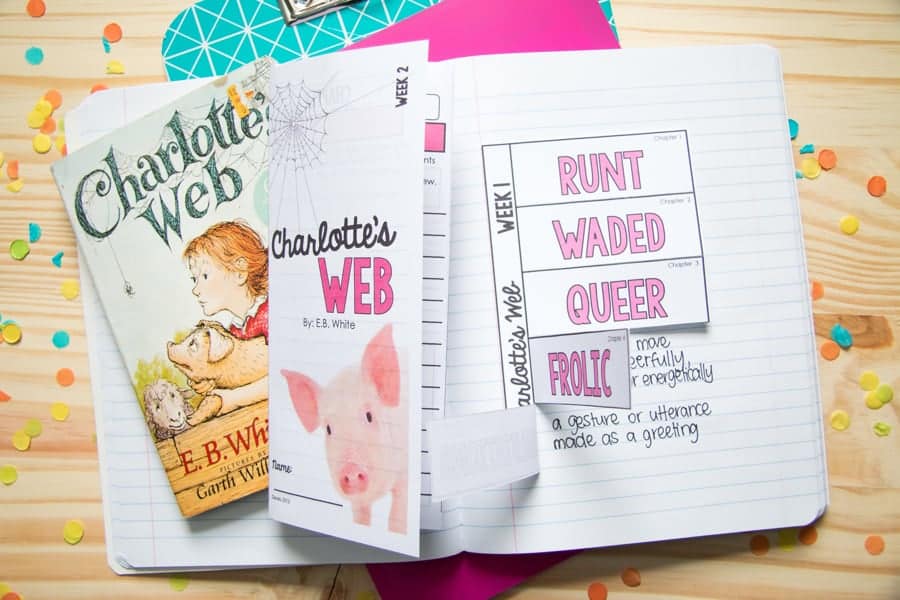How to Teach Character Analysis + Free Character Traits List Printable
Having the ability to analyze the character traits of characters in a short story or novel is crucial in grasping the underlying message of the author. Simple texts typically explicitly state these traits, labeling a main character as kind or brave, in order to assist the reader.
Yet, as students tackle more complex texts, they must delve deeper into the characters and their traits. The skill of accurately depicting characters is a fundamental skill that students must conquer before they can examine how a character’s personality is shaped by the storyline and their interactions with others.
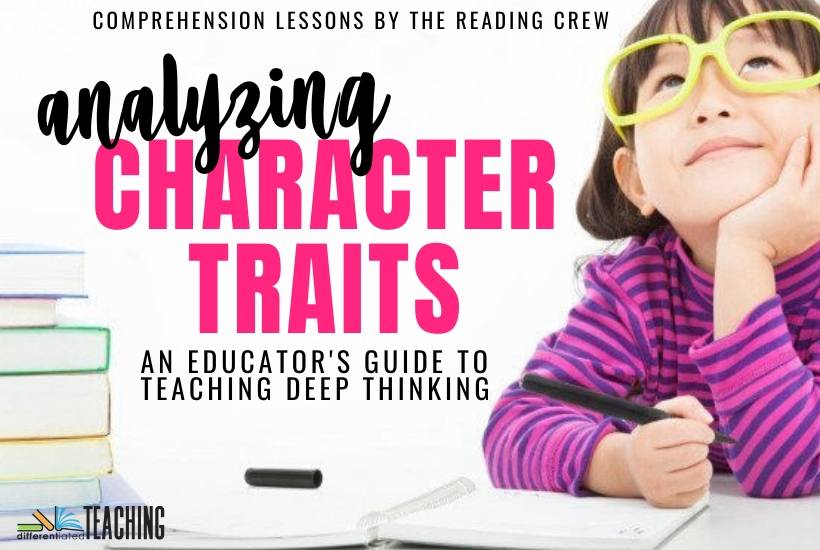
Establishing a strong understanding of positive and negative character traits is essential for success with later skills like analyzing character change.
In this post, I aim to provide some resources about the definition, share examples of character traits, and how you can help readers use text evidence to analyze individuals in literature. Additionally, I will provide some helpful printable materials to assist in conducting these lessons in your classroom.
Why teach character analysis?
Character analysis, or identifying character and personality traits, is an approachable way to get students used to the rigorous expectations for deep thinking about literature. Students must use text clues to make inferences, and they must also be able to support their answers with details from the plot.
Character discussions can be great for building vocabulary and helping students build a bank of interesting adjectives they can use as they begin writing their own stories.
You’ll find you can spiral character analysis skill practice throughout the year and can progressively raise your expectations as students become more proficient.

Getting started teaching character traits
Identifying traits is an important foundational skill. Whether this is your first year teaching reading or you’re looking for some new ideas to incorporate into your classroom, my hope is you’ll find some ideas and ready-to-use resources you can add to your lesson plans for this skill.
Before we dive into the lesson plan, here’s some background information on how this skill fits into the larger picture of teaching reading.
What are character traits?
Character traits are the unique qualities and characteristics used to describe characters – including the individual’s personality and behavior. These traits can be either positive or negative, but in this context, we will focus on positive character traits. When we describe a character, whether it is a protagonist in a novel or a friend in real life, we often look at their attitude and the qualities they possess.
For example, a courageous and adventurous character may be willing to take risks and face challenges head-on. On the other hand, a compassionate character may show empathy and kindness towards others.
These traits help shape a fictional character’s development throughout a story and make them relatable to the audience.
What standards address character analysis?
This skill is introduced in very different grade levels depending on what standards you use. This is a second-grade language arts standard in Texas, and students are expected to apply this skill to analyze character relationships by third grade. The Common Core standards introduce character analysis in third grade and expand upon it through the remaining elementary years.
Here are the Texas standards (TEKS) and Common Core State Standards (CCSS to aid with lesson plan documentation:
- TEKS 2.8B Describe the main character’s internal & external traits
- CCSS RL.3.3 Describe characters in a story (e.g., their traits, motivations, or feelings) and explain how their actions contribute to the sequence of events.
- CCSS RL.4.3 Describe in depth a character, setting, or event in a story or drama, drawing on specific details in the text.
What pre-requisite skills do my students need to have before I begin?
Unlike many higher-level reading comprehension skills, at the basic level identifying these doesn’t require a ton of prerequisite lessons. Once students can recall the main elements of fiction and tell about the main character, they’re ready to begin identifying character traits. In other words, the foundations of comprehension must be solid.
That being said, upper elementary and middle school students will be asked to infer character traits through dialogue and action so the skill itself has multiple layers that progress as students continue through school.
If you’re worried about students’ reading levels or you have a very diverse group of learners, the lesson below outlines a great way to begin teaching this skill because it doesn’t even require students to use text for the initial lessons.
What books are good for introducing & modeling how to identify character traits?
There are so many great books to use with lessons on character analysis. While we tend to look at picture books as mentor texts, biographies are a great option for this skill. The story just needs a strong main character and/or supporting characters that your students can make inferences about.
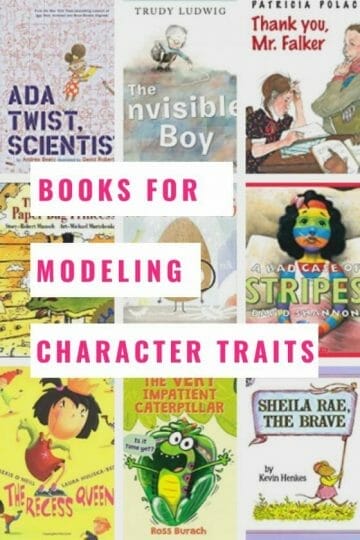
Here are my 10 favorite books for teaching students to identify character traits:
- Ada Twist, Scientist by Andrea Beaty
- The Paper Bag Princess by Robert Munsch
- The Recess Queen by Alexis O’Neill
- Thank You, Mr. Falker by Patricia Polacco
- The Invisible Boy by Trudy Ludwig
- The Very Impatient Caterpillar by Ross Burach
- A Bad Case of Stripes by David Shannon
- The Good Egg by Jory John
- Sheila Rae the Brave by Kevin Henkes
- Boundless Grace by Mary Hoffman
Before Reading: Introducing Character Traits
Character traits can be hard for younger learners to grasp. While many things are spelled out for them in early readers, character analysis requires students to make inferences based on clues in the text.
When introducing the skill, it is important to begin by helping students define the term. Examples and non-examples can be a powerful strategy for building understanding.
Students must be able to differentiate between what a character looks like – their appearance – and their internal character. You’ll also need to differentiate between emotions and character traits.

One great way to do this is by modeling these differences using yourself or a student in your class. Have students take turns giving examples of physical attributes first. Then transition to discussing the traits of that person. When you finish, compare the two lists to help students internalize the differences between the two.
Here’s a great example of an anchor chart for your class as you begin this foundational work.
See more great examples of great character traits anchor charts.
Once you’ve done this as a group, you can even have students break off into groups. They can complete an example using themselves or another classmate.
The great thing about doing this first is that it doesn’t require text. Your struggling readers get the chance to understand the skill without using all their mental energy on decoding.
You may also consider creating a list of traits as a class. Alternatively, you may share and discuss this free character traits list pdf download. This can help students build vocabulary.

If you feel your students might need additional practice before they identify these traits in text, you can work backward by assigning each student a trait and having them write about how someone with that trait might think, act, or speak to others. This can help students tune into what clues the text might provide.
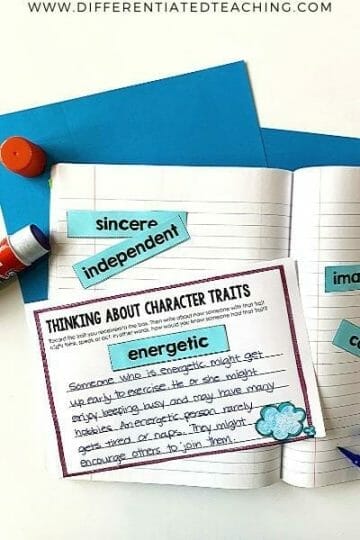
Transitioning to Text: Guided Practice
Once your students have a solid grasp of what character traits are, you’re likely ready to transition them toward identifying the traits of characters in a short text.
At this point, I like to pick a picture book to use as a mentor text. My favorite for upper elementary is A Bad Case of Stripes by David Shannon. A great alternative for younger students or those with shorter attention spans is No, David! from the same author.
As you read, have students pay attention to the main character’s thoughts, words, actions, and feelings. Stop to discuss what traits they can infer along the way.
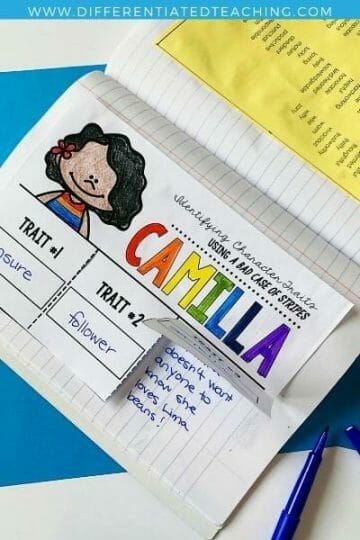
After reading, use the free flipbooks to help your students document the traits they observed. Under each flap, they should provide evidence from the text supporting their identified trait.
Depending on the text you select, this can also be a great spot to begin the discussion of positive vs. negative traits. You can even use the cut & paste activity included to help your students sort traits into three categories – positive, negative, and neutral.
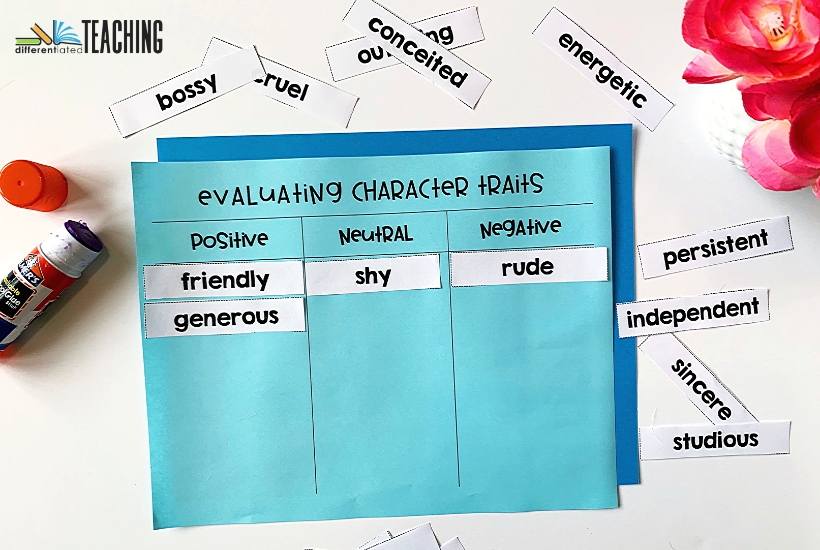
Independent Practice Options
Once students seem to have a solid grasp on this skill, there are many different ways you can incorporate this into independent practice.
One great option is encouraging students to discuss these traits during their literature circles or guided reading. I’ve included a free graphic organizer that students can use to organize their thoughts and record text evidence for their book.
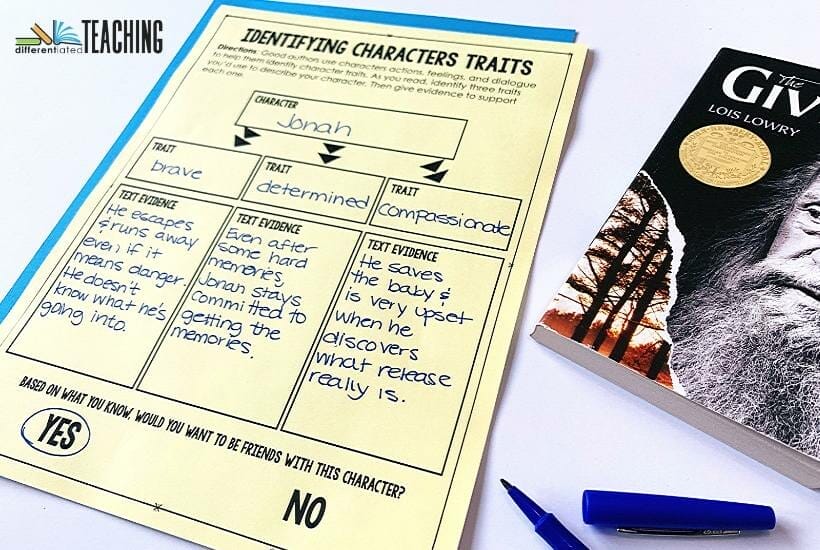
Here are a few ways you can offer some fun additional practice:
- Use free online games to practice the skill & keep students engaged
- Use task cards to have students practice identifying traits
- Have students create a Wordle for a character in a book they’ve read
Grab the free resources for teaching character traits
Now that you’ve read about how you can get students to think deeply about characters and their traits, I’m sure you’re ready to tackle this in your classroom.
That’s why I created a set of free resources for teaching this skill. In this free pack, you’ll find:
- Character traits list for reading journals
- Graphic organizers – internal vs. external, text evidence, comparing characters
- Comparing characters graphic organizer
- Character trait writing task – differentiated options available
- Trait sort – positive, negative, and neutral traits






